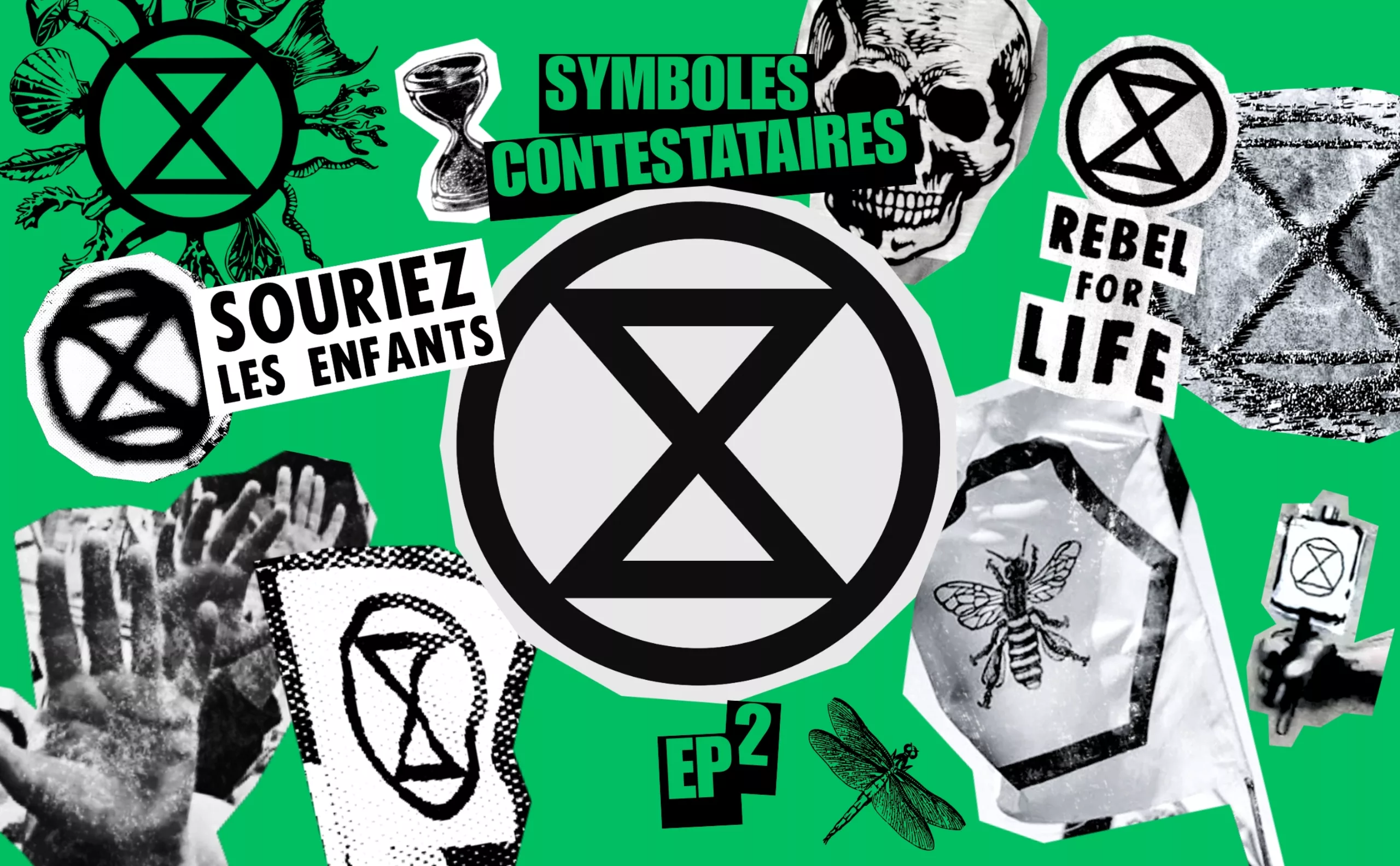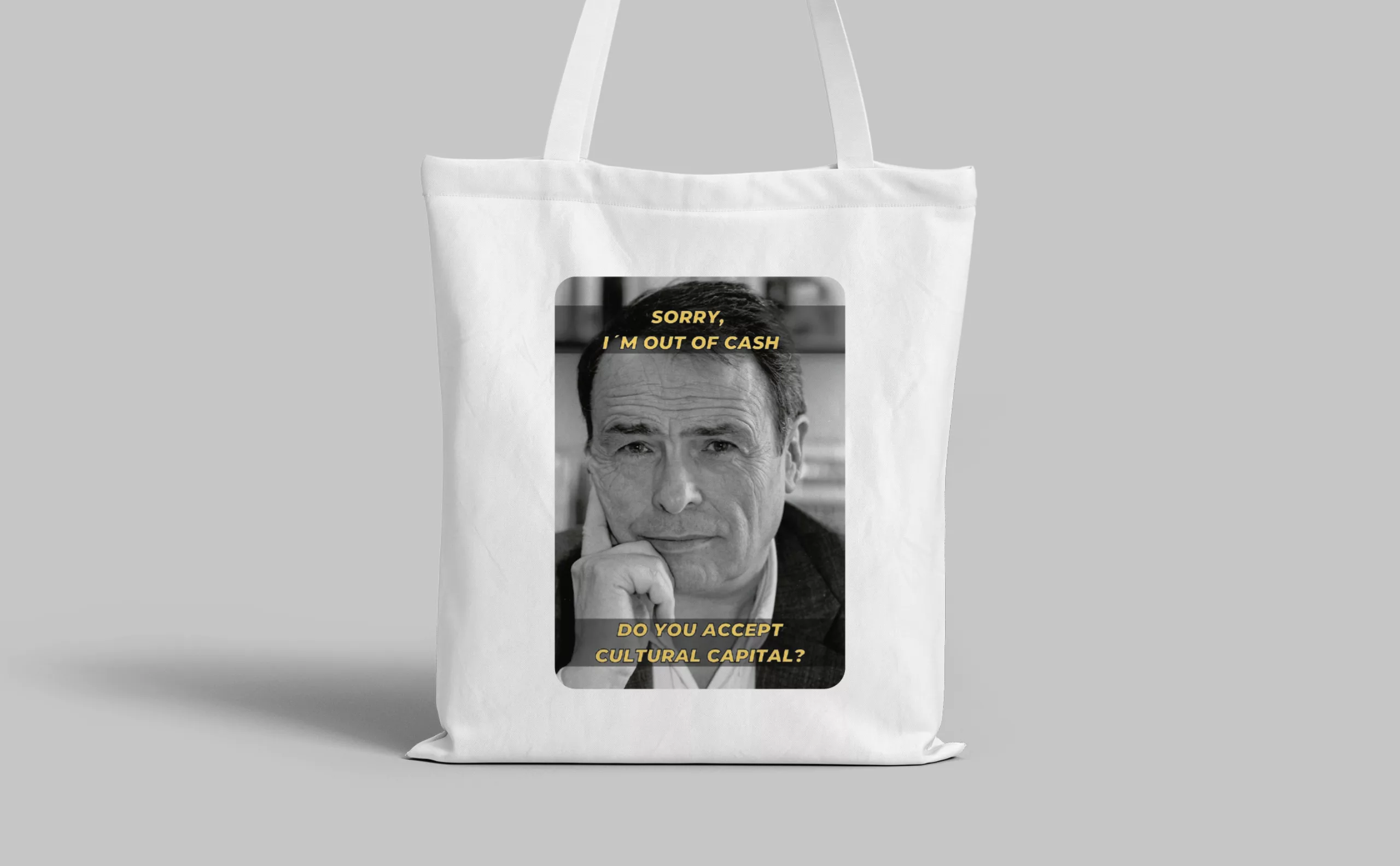Evian x Balmain, a deep water co-branding strategy
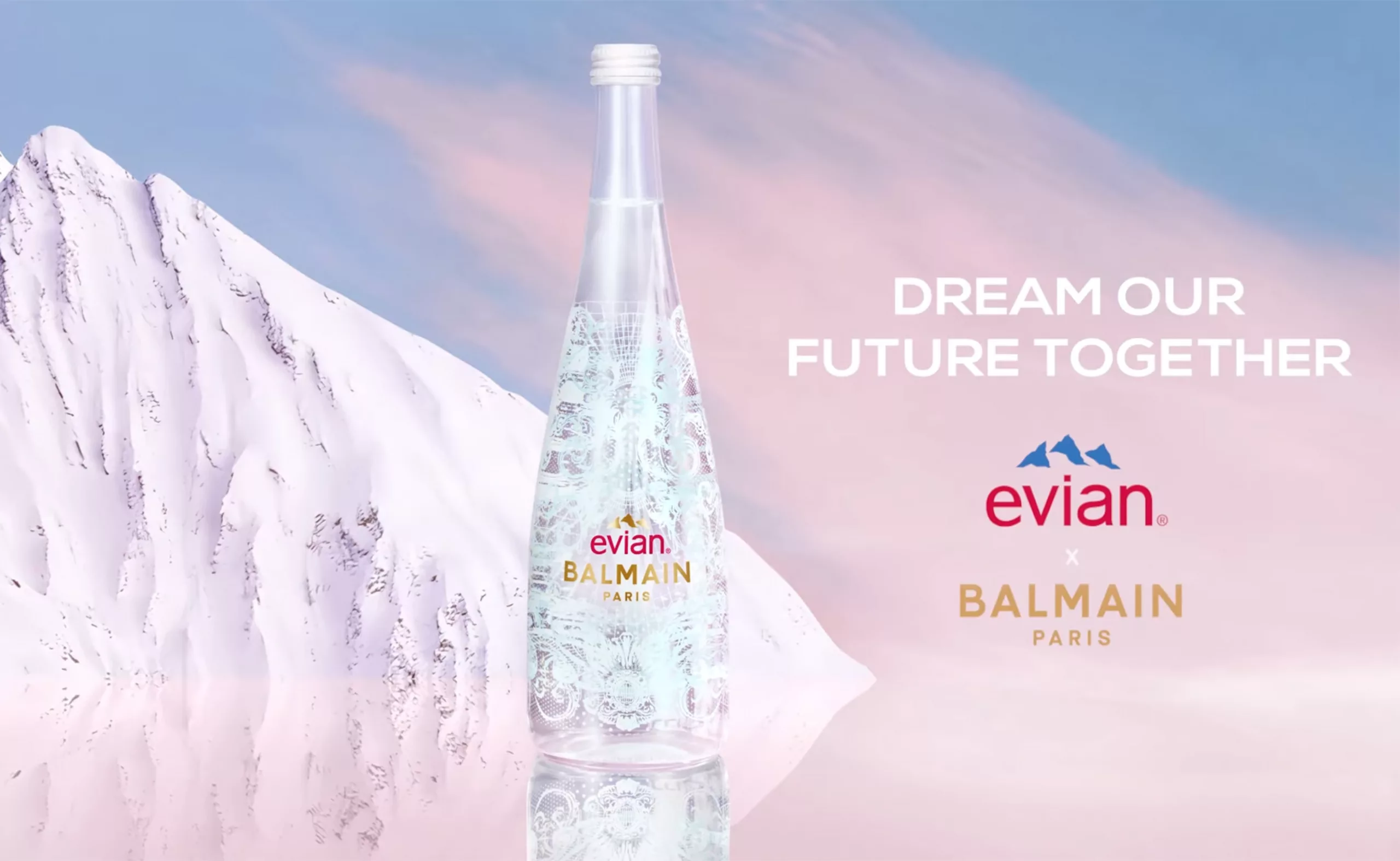
The evian x Balmain collaboration, “for future generations”?
Last April, evian water and the fashion brand Balmain launched a collaboration to “imagine together sustainable innovations for future generations” embodied by a joint evian x Balmain campaign. The campaign features a limited edition engraved water bottle held by Olivier Rousteing (Balmain’s DA) and dancers in pastel-colored garments. “We are delighted to launch this first evian x Balmain ready-to-wear collection, which evian and Balmain fans around the world will be able to purchase online and in stores,” notes Dawid Borowiec, global director of evian. You’ll have to pay €590 for the organic cotton and recycled polyester t-shirt, €250 for the bob and €2,890 for the jacket.
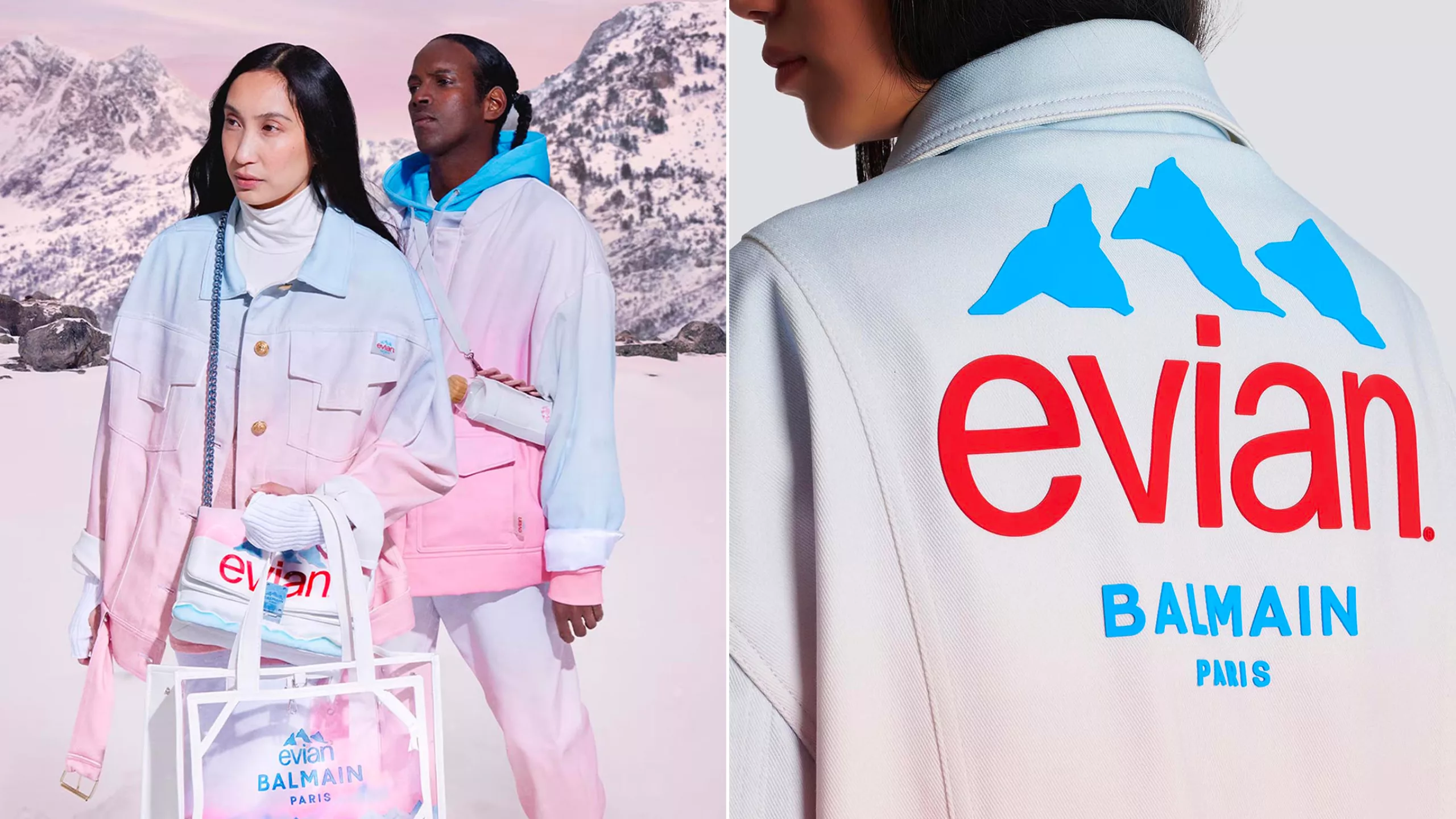
Collaborations between brands are not new and evian previously worked with Virgil Abloh, Elie Saab, KENZO, Alexander Wang, Christian Lacroix, Chiara Ferragni, Iseey Miyake or Iris Van Herpen to design unique evian collector bottles or recycled PET dresses. This latest collaboration is expected to allow evian and Balmain to highlight their future commitments in terms of ecology, including for the first the development of a technology to create 100% recycled plastic bottles by 2025, and for Balmain to “offer a more sustainable approach to fashion” with a limited evian x Balmain capsule collection in organic cotton, recycled polyester and cardboard packaging from sustainably managed forests, as well as a unique haute-couture dress made from PET thread from recycled evian bottles, proving that it is possible to make beauty out of waste.
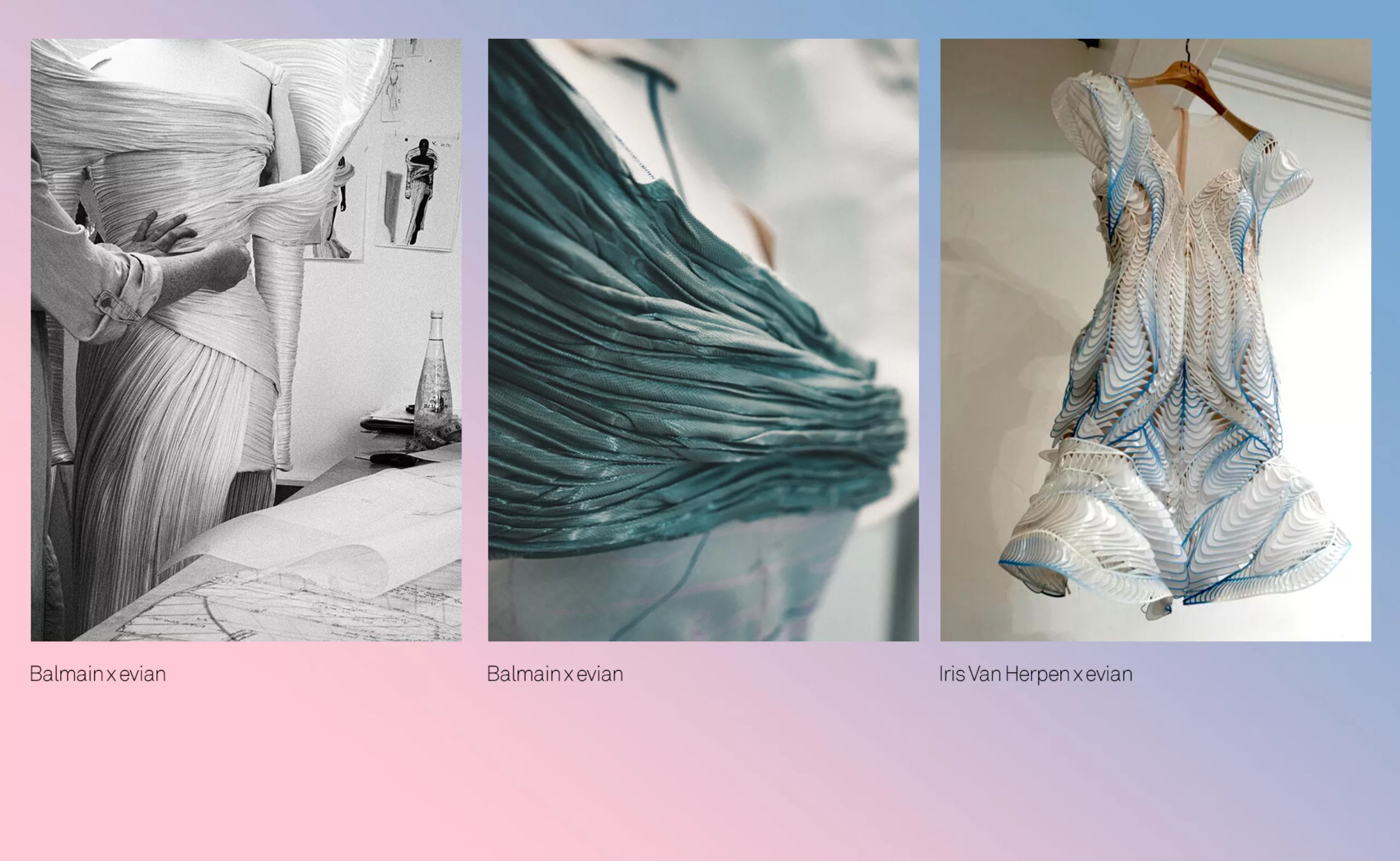
The communication campaign and the clothes use a pastel gradient of pink and blue around white, three highly symbolic colors. Pure and innocent par excellence, they symbolize life, dreams, glaciers, paradise or anything related to divinity, and mostly virginity. These are the colors that we find in the frescoes and paintings representing the robes of angels or the Virgin Mary. In the snowy summits, in the immaculate whiteness, dancers execute a group choreography to symbolize collective strength.
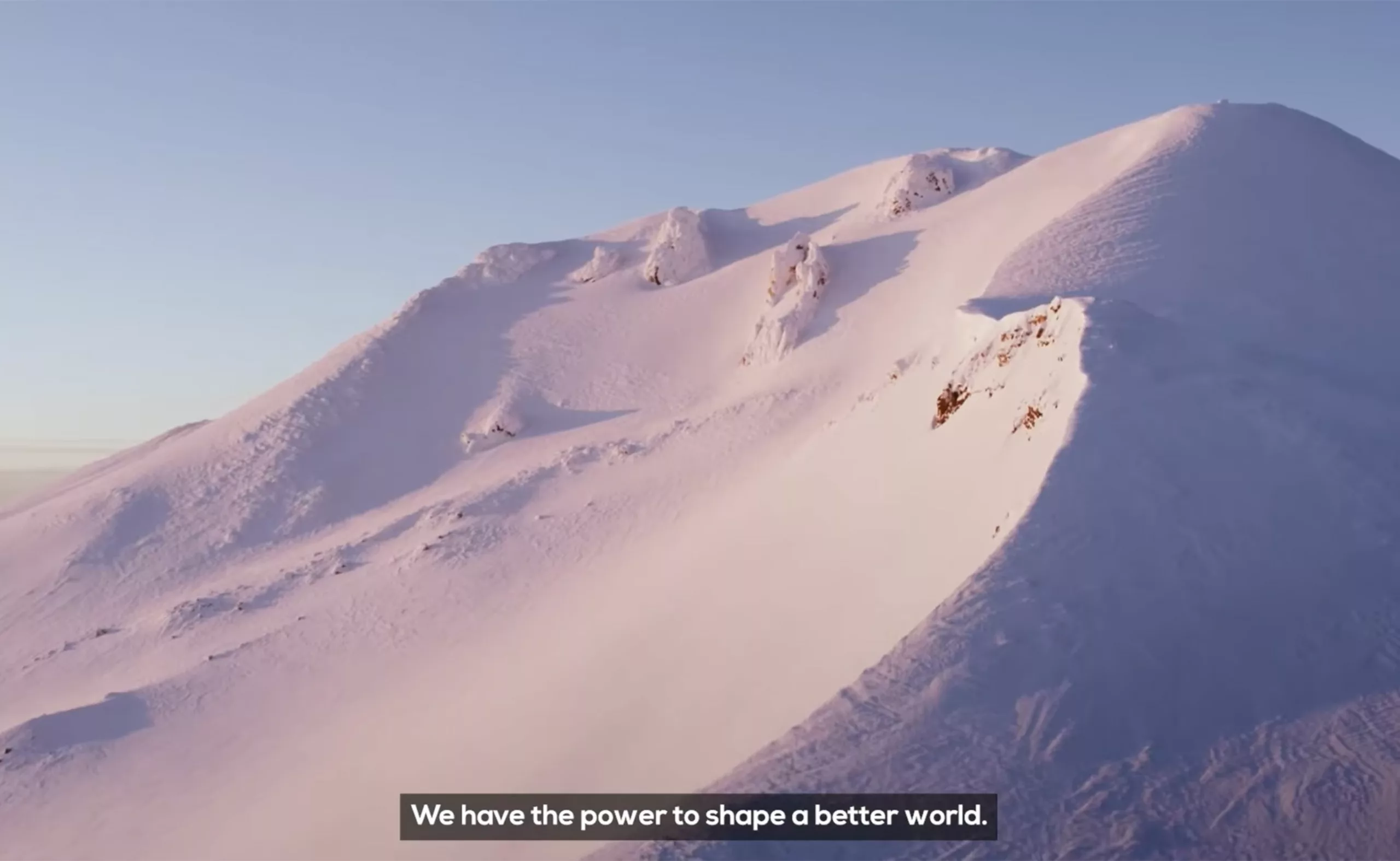
The message is visually clear and hopeful: evian spring water is the incarnation of transparency in every way and is committed with Balmain to “help the next generations live in a better world, create a safer place and take care of our planet” as Rousteing writes on his instagram account.
Evian, a promise of everlasting youth and life
Where others promise to improve your transit, or simply quench your thirst, evian stands out by communicating with babies and childhood, insinuating that their water comes from nothing less than the mythical source of youth! This positioning is even more asserted and declined since 1998 with the worldwide success of the advertising spot created by the BETC Euro RSCG agency where 70 babies performed an aquatic ballet to the sound of the music “Bye Bye baby” by Bay City Rollers in a setting inspired by Hollywood choreographies. The figure of the baby and the return to childhood has since become central to evian’s image with the slogan “Live Young”.
The Fountain of Youth is a spring that is supposed to restore the youth of anyone who drinks or bathes in its waters. Evian water offers a rebirth, as if drinking directly from this mythical fountain: a symbol of immortality told around the world for thousands of years. Youthfulness and immortality, these are arguments that resonate with the anxieties of our time!
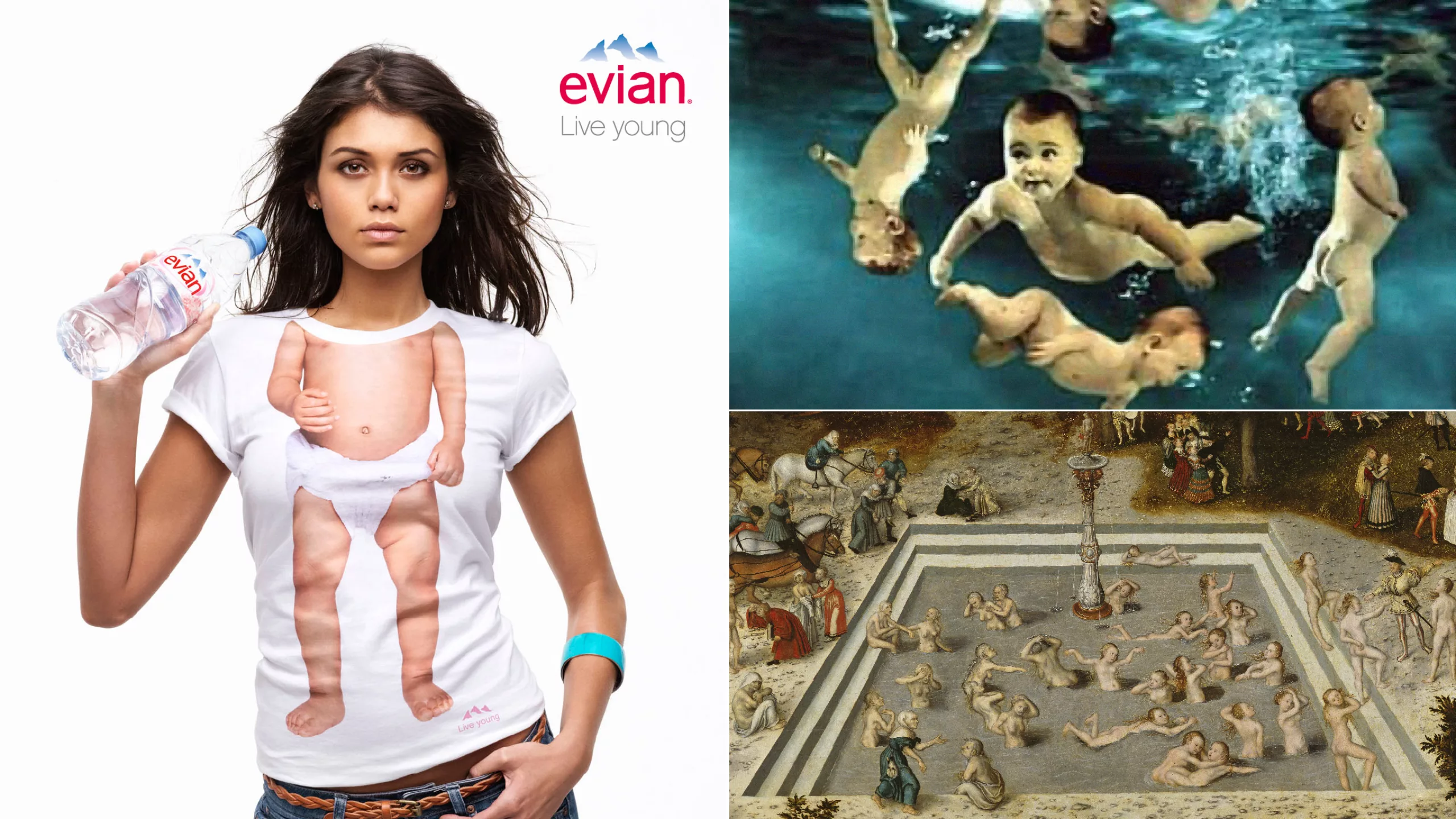
A logo makeover: back to the roots
The logo has been slightly lifted (on the clothes and the recycled bottle, not on the glass bottle), surely announcing evian’s future logo: the tip of the e becomes horizontal and the white of its two counter-forms is balanced. Same thing for the a, which loses the hollow of its drop for a more tense version. It swaps its curved exit for a straight one, gaining contrast at its junction answering the junction of the n which makes its leg gush out like a spring. Finally, with more white in its counter-forms, the global approach of the block is tightened. The new design gains in coherence, erasing some anomalies of contrast and style due to a mix of various influences (an e with a vertical exit rather humanistic to Gill Sans, a v contrasted, a very curved with a horizontal cut, a geometric n and without contrast) to harmonize the whole in a grotesque lineal, slightly contrasted and harmonious. A subtle makeover for this “purity and lightness” brand with an almost unchanged logo since the discovery of its spring in 1789, bottled since 1826. Since its beginnings in France in the 1950s, bottled water has always been marketed as a healthcare product rather than as a commodity: bottled evian water (then made of glass) is a niche product sold first in pharmacies for baby bottles or as “healthy” water as a food supplement.
In 1978, the evian logo adopted the silhouette of the Alps, to emphasize its French origin on the new American market. The a suggests a drop, and the red recalls life, blood. At the dawn of the 2000s, the brand was adorned with a pink oval, an allusion to Lake Geneva, whose sources are nearby, and to the water cycle, symbolizing the brand’s flight into global markets. In 2019, the brand’s mountains turned gray, announcing a more sustainable shift. In 2023, evian gets closer to its original 1973 typo while keeping its blue mountains. A return to its roots, much like Burberry did, and the loop is complete.
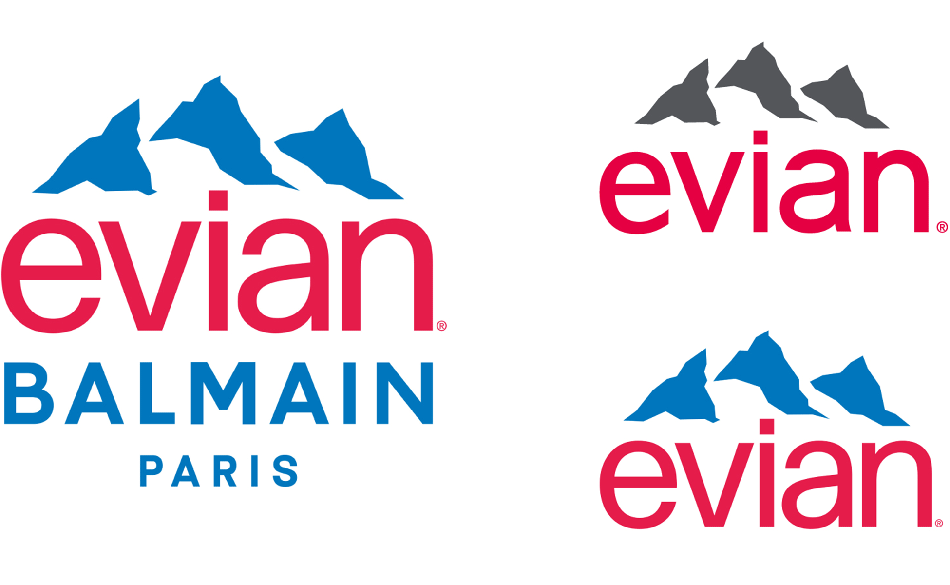
Balmain on its side is also a house with a sans serif typo logo, which has moved towards graphic minimalism in 2018. We talk about this trend in our article about minimalism and also in the one about Burberry. Nonetheless, these beautiful promises and this apparent sustainability feel like oil and water.
Evian makes waves
If we take a step back from the advertising filter and consider this campaign in the current context, whether ecological (impact of plastic pollution) or social (crisis of buying power, growing inequalities and scarcity of drinking water), we cannot help but believe that it is at best a joke, at worst a misplaced provocation, and above all to consider that water, this supposedly universal common good, has really become a luxury good. This campaign launched during the protests against the pension reform has the effect of the famous sentence written by a “great princess” quoted by Rousseau “they don’t have bread? let them eat brioche!” illustrating the gap between social classes. Because of the costs of production and bottling, marketing and distribution (i.e. everything that revolves around the bottle) bottled water is 1762 times more expensive than tap water. Still, France is currently one of the 5 countries with the highest consumption of plastic bottles (FranceTV)! An economic and ecological nonsense.

If Evian water flows freely from the Cachat fountain in Evian-les-bains for Evian residents and others who have the courage to make the daily round trip, “the Cachat spring belongs to the Société des eaux minérales d’evian“, which has privatized the source. Wherever fresh water is available in the world, access to it is often inaccessible to citizens who have neither the capacity to extract it from the ground, nor to make it drinkable or to transport it, who are forbidden to access it by the authorities or conflict zones, or who simply are not aware of its existence. Freshwater represents only 2.8% of Earth’s waters, stored in natural reservoirs and by 3/4 in ice and snow, but only 1% of this freshwater is accessible. As for rivers, they are mostly polluted because more than 80% of wastewater from intensive activities in the world is released into the environment without being treated, according to the UN. The organization declares that access to drinking water is a “fundamental human right”, although even today 60% of the world’s population does not have access to clean water, with unsafe water being one of the leading causes of death in the world, according to the WHO and UNICEF.
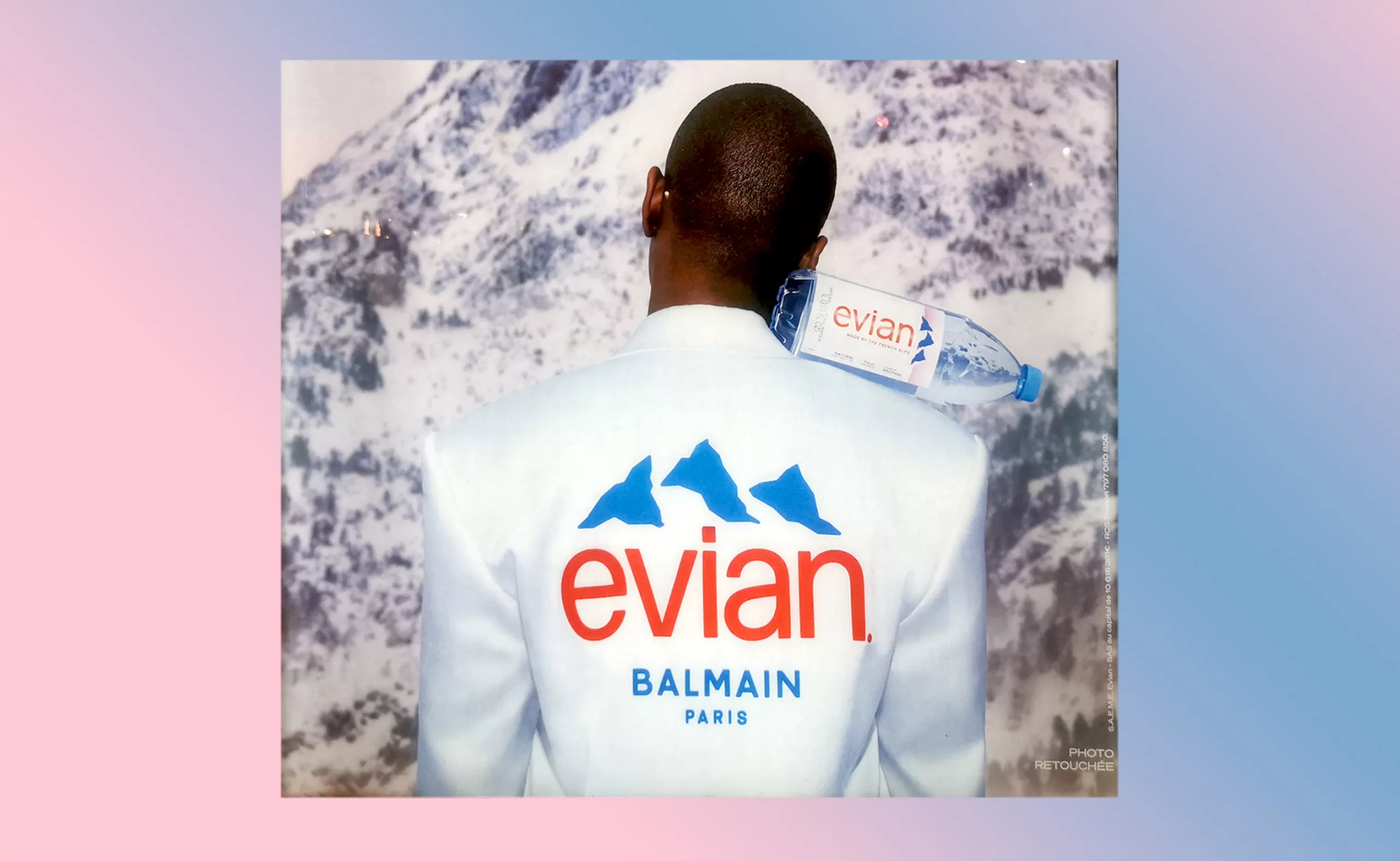
Isn’t offering a water bottle signed by a luxury brand twice inappropriate? We have already seen Balanciaga make a scandal with a 1750€ leather garbage bag, a tote bag with IKEA colors or used sneakers for about the same amount. The limit between artistic creation and pure provocation is thin.
But in response to growing concerns about plastic pollution, the water market has invented “high-end” bottles with careful work on the design of the bottle or the graphics of the labels, and even offers sommeliers to advise restaurant owners. Water has thus become a unique branded good, as a distinguished product sometimes enriched with minerals, oxygen, or even pure glacier or rain water. As with Balanciaga, the goal here is to transform a basic need into a luxury product, an approach known as luxification.
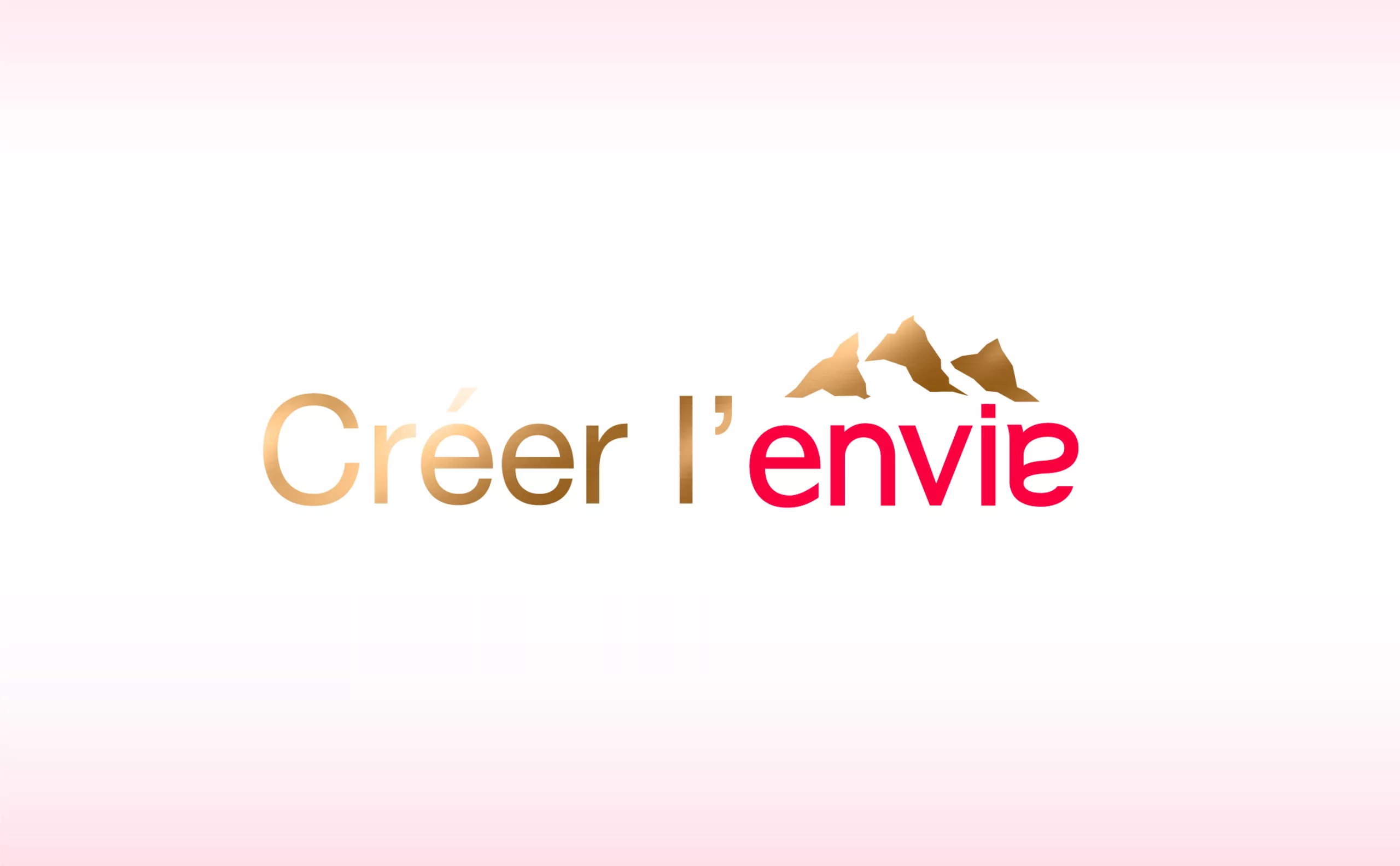
Out of water and luxification
Luxification consists of adapting the principles of the luxury sector to other industries that do not usually use these codes, such as retail, restaurants, food, housing, etc. This approach is aimed at brands that are not considered luxurious but are part of consumers’ daily lives. Evian fits perfectly into this category of consumer brands seeking to become high-end. For example, if you are lost in the desert and thirsty, you don’t dream of having a fashionable bag, but rather a big bottle of fresh water, for which you would be willing to pay a lot of money.
This luxification phenomenon is not limited to the improvement of packaging or premium product design. Its main objective is to offer an exceptional customer experience, expanding the brand’s territory both in the concrete and figurative sense. Luxification aims to broaden the brand strategy by offering richer experiences for customers, beyond the simple possession of a superior product or service. The marketing mechanisms are classic: marketing of rarity, product desirability, advertising aesthetics, brand ritual, sense of place, etc…
The objective is, for example, to transform a point of sale into a living space (e.g. Apple’s Genius bar), by creating a unique lifestyle that reflects the brand (e.g. Maison du Monde opening a 4-star hotel), by transforming a standard product into an iconic product (e.g. evian x Balmain), etc. In other words, the objective is to create a global experience that goes beyond the simple commercial transaction and differentiates the brand from other market players.
In our society of paroxysmal over-consumption, consumers reject standardization and seek “made-to-measure”, “less but better”, preferring quality to quantity. These neo-consumers are sensitive to the good (hedonism), the beautiful (style), the true (authenticity) and the good (ethics/ecology). Evian and Balmain, through this collaboration, offer us a blatant example of poorly controlled luxification, where everything seems “good, beautiful, true and good” on the surface, but where the ethical/ecological veneer and the authenticity of the approach hit the wall of greenwashing.
Cristal clear greenwashing ?
Following the evian x Balmain collaboration, many people have already complained about greenwashing, as reported in this video from Le Monde. Evian and Balmain use the “hidden compromise” and the “lesser of two evils”, two of the “7 sins of greenwashing” (according to Terra Choice) consisting for the first in talking about only one aspect of the product without taking into account its entire production chain up to its recycling – i.e. talking about a plastic water bottle without mentioning the cap or the recycling problem – and for the second in diverting the consumer’s attention by highlighting the alleged ecological character of the product while keeping its real impact under silence – i.e. to use the “lesser of two evils”. The second is to divert the consumer’s attention by highlighting the product’s alleged environmental impact while ignoring its real impact – i.e., to create a new fashion collection and promote the merits of a plastic bottle. According to ADEME, the term greenwashing is used to “qualify any advertising message that can mislead the public on the real ecological quality of a product or a service or on the reality of the sustainable development approach of an organization.“
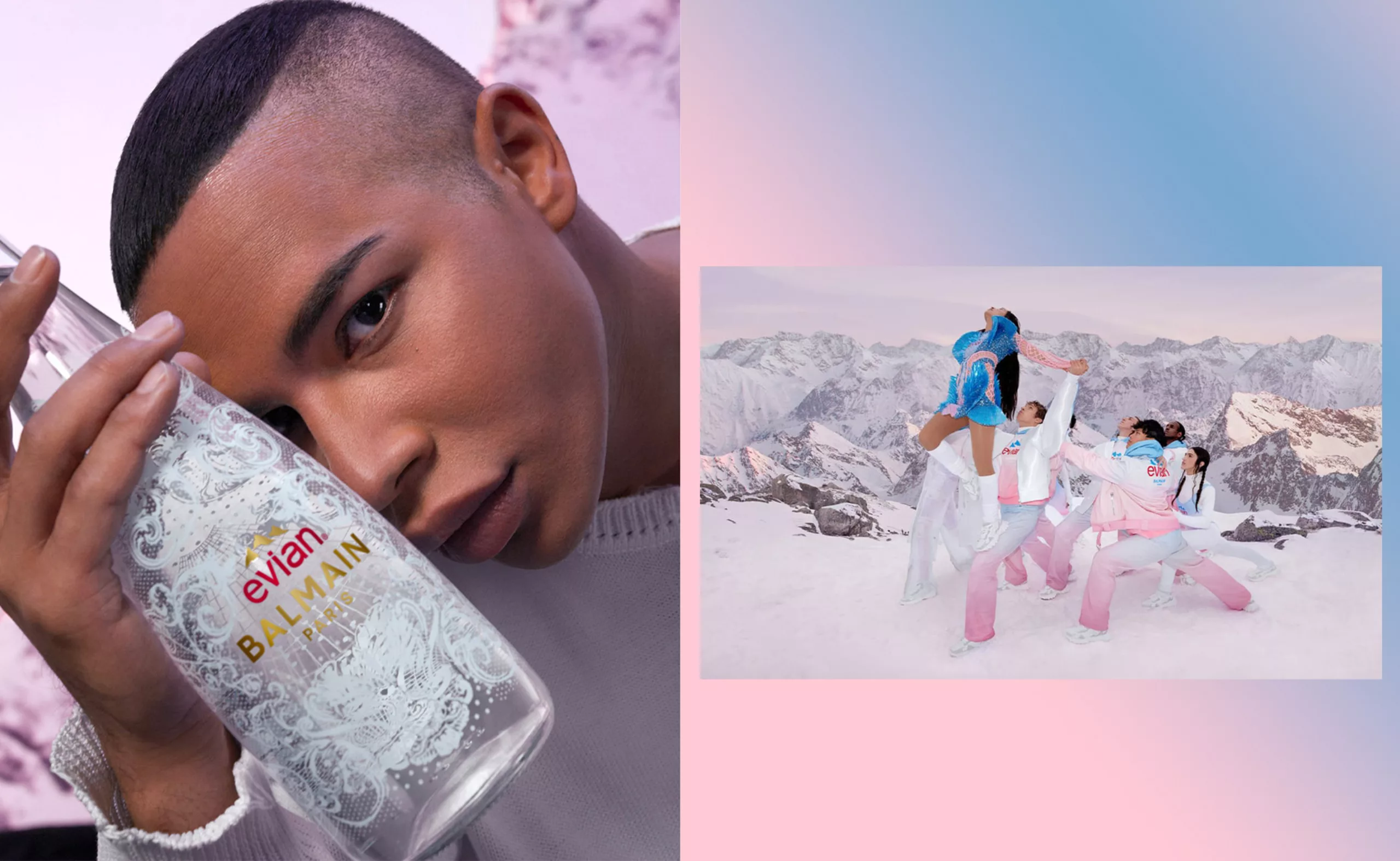
Here, while “Balmain’s and evian’s shared commitment to eco-friendly practices can be found down to the smallest detail, including recycled polyester labels and composition stickers, paper packaging that uses pulp from sustainably managed and FSC-certified forests, as well as hangers and bags made of recycled plastic” as one can read on their website –which is appreciable but should surely be the norm and not the exception in the textile industry (and which Balmain does not apply to all its collections…), the limited capsule edition strategy goes in the opposite direction and seems nothing but a committed act. The capsule creates a desire for fast consumption because it is limited in time, engaging an impulsive purchase for an unnecessary product, instead of a reasoned and really committed act. Not to mention the speculation made on this kind of collection, whose products are resold at a high price once the stocks are exhausted.
This creates a real contradiction between the announced sustainable ecological commitment, which should lead to a certain form of reasoned sobriety, sustainability and preservation of resources for the benefit of the largest number of people and future generations, and the advertising strategy which, in turn, encourages a compulsive, individualistic act, without any reflection on the consequences of these acts, in order to satisfy an unlimited desire. This contradiction often arises when ecology and consumption or advertising are associated, and when the consumer is not misled in his decision making, we can ask ourselves if it is not a blessing in disguise? Isn’t wanting to do better, even not perfectly, already more encouraging than doing nothing at all? The collaboration with Iris Van Herpen in 2020 also gave birth to a haute-couture dress made from recycled plastic bottles, which made far fewer waves. Unlike Balmain, the Dutch house only designs unique dresses based on innovative materials inspired by nature and “concerned with sustainable development”, never entire collections and even less capsules…
Together is better!
The new evian bottle is a drop of water diluted in a plastic ocean. By 2025, evian is committed to producing label-free bottles and made of 100% recycled plastic (excluding caps), compared to about 25% today, thanks to its partnership with Loop industry, which allows the recycling of all PET plastics manufactured by this technology, avoiding the loss of quality of the material. This is a really encouraging technological revolution in the world of plastic bottles which shows what the industry can create. On the other hand, as for the concept cars, the announcement causes a sensation but in practice this niche model is not yet sold to the general public, so the pollution problem remains.
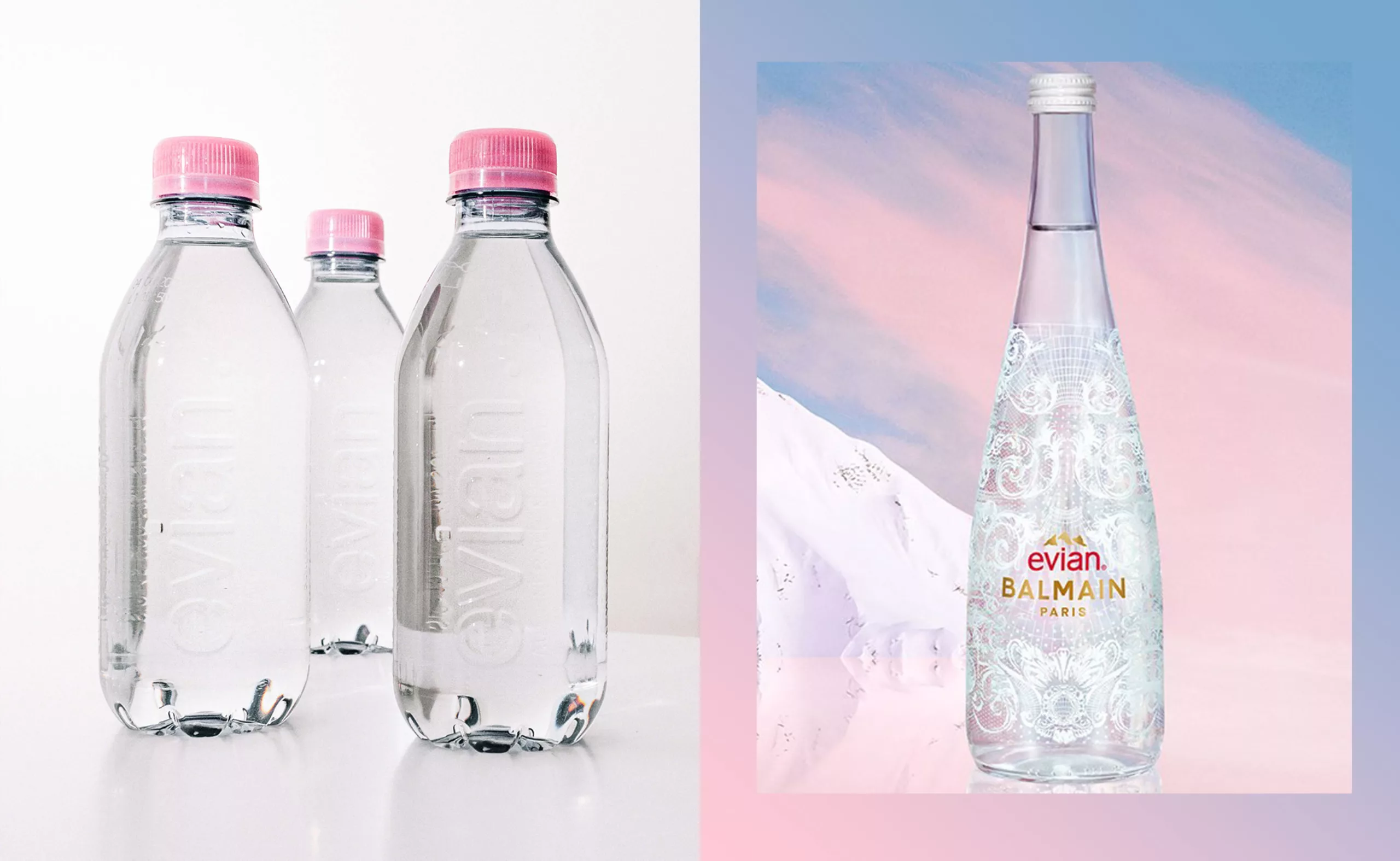
Coca-Cola, Sprite and Fanta have already developed 50cl bottles made of 100% recycled plastic (still excluding caps and labels), but this is not enough to fight against the plastic pollution generated by the big brands. The Danone group, owner of evian, is the 8th largest plastic polluter in the world. The change promised by evian to market bottles without labels in 2025 or 2030 seems far and unambitious in the face of the 1 million plastic bottles sold every minute in the world. For there to be a real impact, these brands would have to change their packaging together and quickly, instead of promoting their products individually.

The fashion industry alone uses 4% of the drinking water to grow cotton in “hydric stress” areas. Would the solution be to stop everything? Wouldn’t it be better to tackle the root of the problem? We were talking above about a “lesser of two evils” strategy; brands offering recycled or recyclable products are bragging about this as a sustainable solution, but is it?
Is recycling a sustainable solution?
Recycling is an incomplete solution to waste management because it is often expensive, energy consuming and waste is often sent for burning overseas 1 where processing practices are rarely appropriate. Only 9% of the world’s total plastic has been recycled since its inception2. It is difficult to sort the different types of plastics and their quality deteriorates during recycling. To produce a recycled product, virgin raw material must also be injected. Wouldn’t it be more useful for manufacturers and consumers to work together to reduce waste at the source, improve product design with less plastic, promote reuse and adopt sustainable lifestyles?
If bottled water allows to bring this first necessity in poorer countries or in “hydric stress”; by privatizing and commercializing this common good, it is far from being the only drinking solution. Before counting only on technological solutions of the future, we can act today with existing solutions such as returnable glass bottles, aluminum packaging (which, unlike plastic, is infinitely recyclable and requires little raw material), tap water obviously (for countries that have this luxury) or filtering and disinfection solutions for the others. Since 2022, public establishments in France have been obliged to install free water fountains connected to running water and are forbidden to sell plastic bottles. There are also still and sparkling water fountains in the city and for the most suspicious, this site shows the quality of water in France: refill, citizens!
Evian has understood that ecology will be its best marketing argument for the years to come, and has created a glass and bamboo water bottle in collaboration with Virgil Abloh, former DA at Louis Vuitton. Newly redesigned in the colors of Balmain, it is sold for 50 euros for the collaboration with evian. As far as fashion is concerned, isn’t true sustainability not only in the choice of materials, both natural and respectful, but also in a rational use?
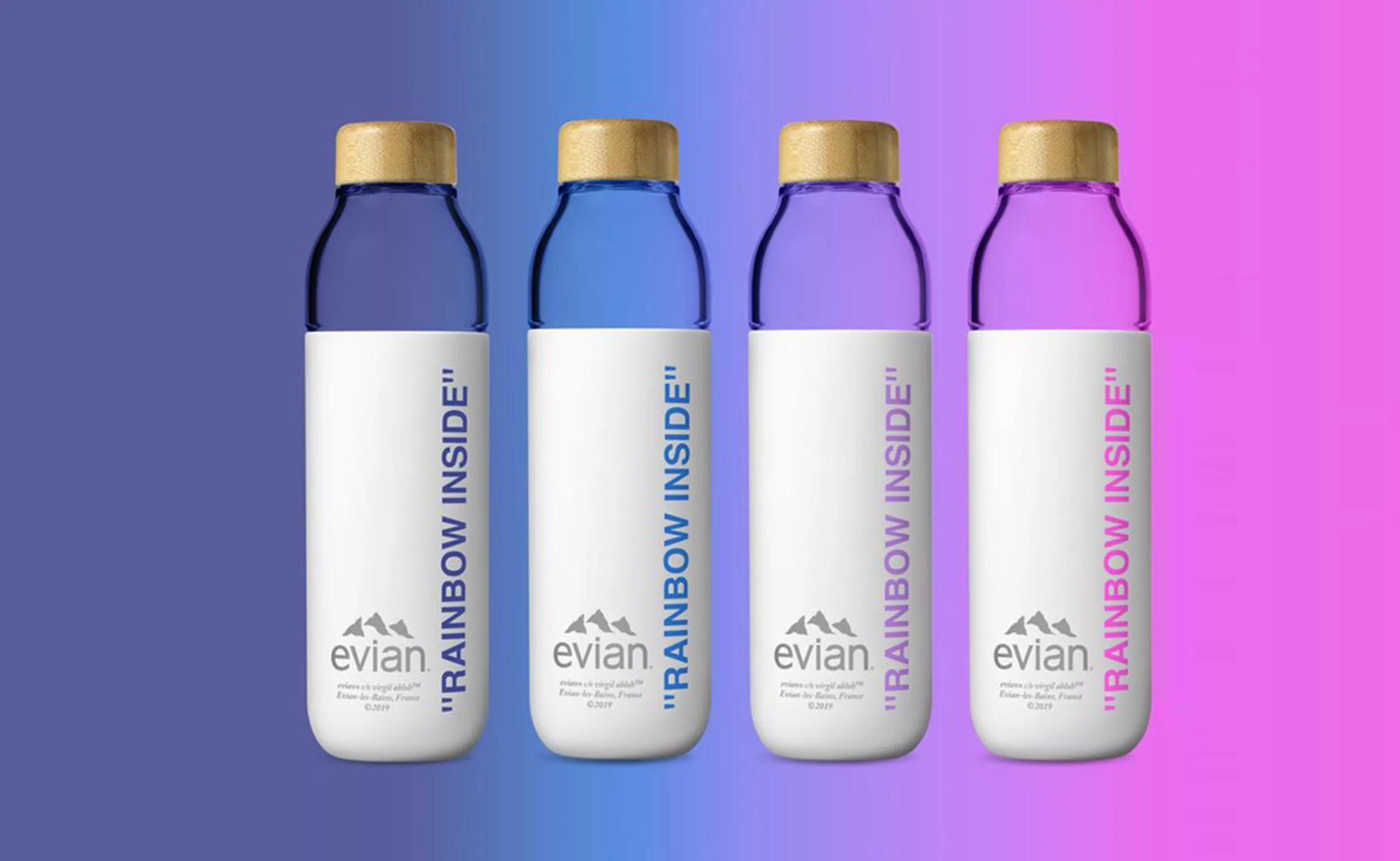
The world’s number two bottled water company is labeled “carbon neutral,” meaning that evian offsets its own CO2 emissions with recyclable plastic bottles (available in two or three niche retail outlets), renewable energy plants, educational documentaries and by planting trees. Evian pledges to “continue relentlessly to seek new, revolutionary and sustainable ways to limit our waste, promote recycling and limit our environmental impact.” In practice, in Europe, companies that market products containing plastic or recyclable materials are expected to be responsible for their end-of-life; something that is impossible to do on a practical level because the bottles are no longer in their hands. To do this, these brands finance eco-organizations to raise awareness among citizens, which puts the ecological responsibility on the users and not on the producers, when both have a common role to play.
By avoiding this major problem, the company (which is far from being the only one) lets the consumer deal with the pollution it has created: is it possible then to “dream our future together” under these conditions?
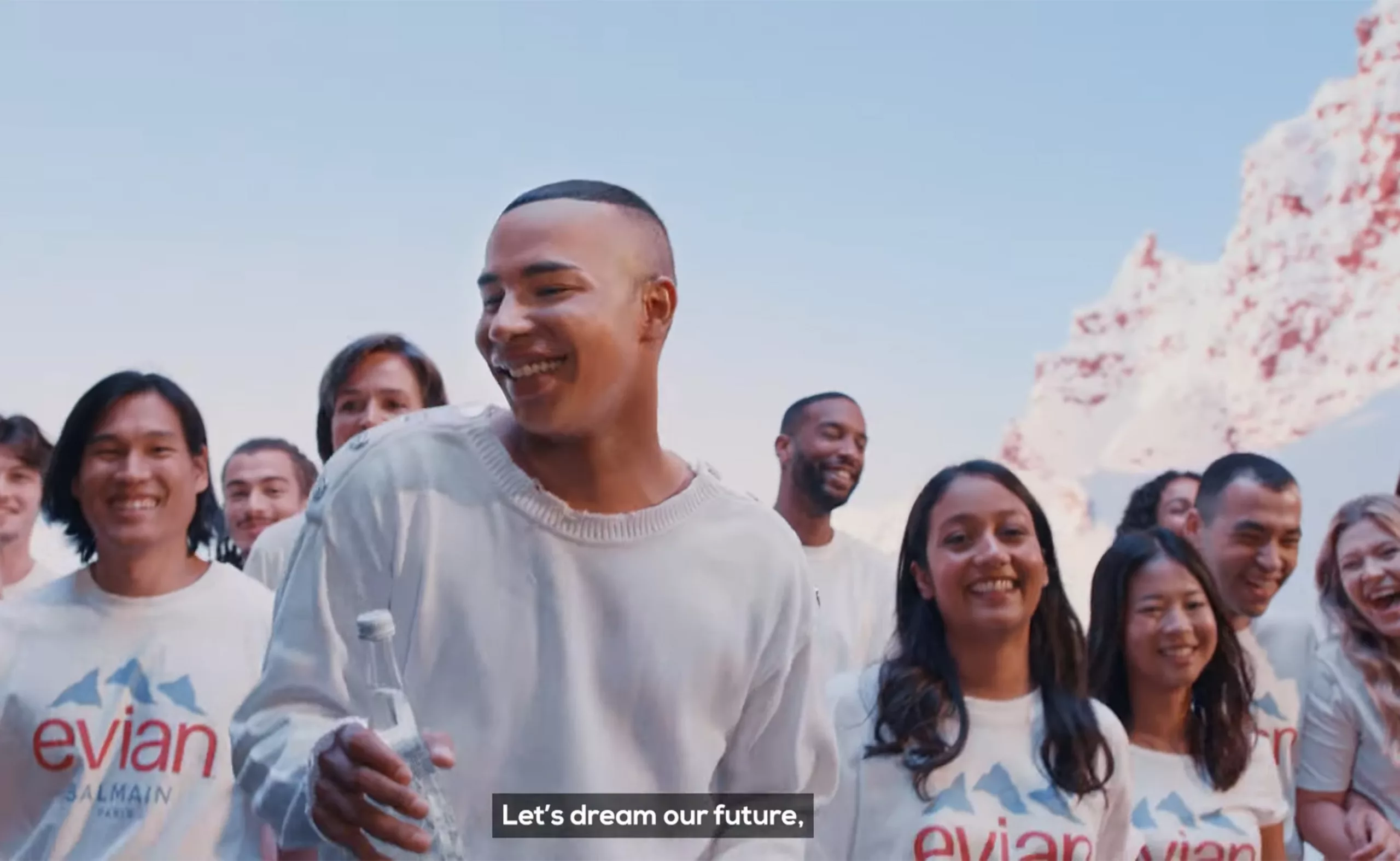
Sources, to go further:
- datas and solutions anout fashion industry and fast fashion : le Monde, “la mode est l’une des industries les plus polluantes au monde”, wedressfair “pourquoi la mode est polluante”, infographie qqf “cycle de l’eau, attention aux fuites”
- on freshwater and the botlled water industry: infographie qqf “cycle de l’eau, attention aux fuites”, jamais la même histoire “l’eau en bouteille”
- on recycling and plastic pollution: novethic, “100% de plastiques recyclés en 2025, un objectif irréaliste”, the Guardian: “Plastic recycling myth, what really happens to your rubbish”, national geographic “le plastique en 10 chiffres”, infographie qqf sur la pollution plastique et sur le recyclage “fausse bonne idée”
- further solutions: reporterre “le retour de la consigne”, infographics about our daily consumption of water, the map of water fountains in France and the map of sparkling water fountains in Paris
1 the Guardian: “Plastic recycling myth, what really happens to your rubbish”
2 “The New Plastics Economy: Rethinking the future of plastics”
